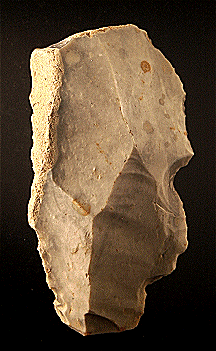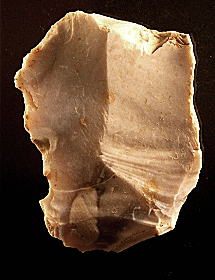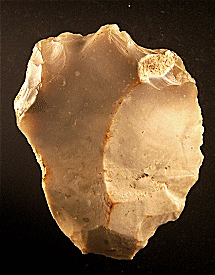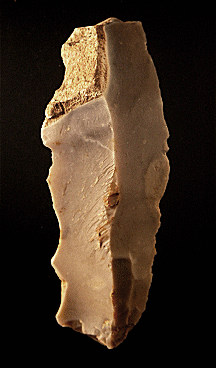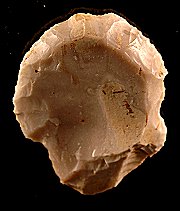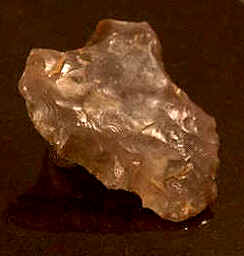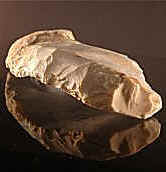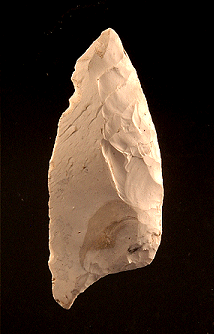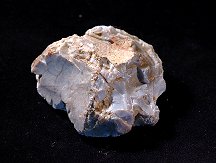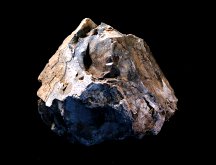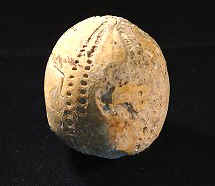|
What on Earth is this? - Have
I found a Stone Age tool?
Q.
I found this object in my garden/while walking the dog/on the
beach/in my grandad’s shed. It looks just like an arrowhead/spearpoint/hand axe/ pointy Stone
Age thingy – is it a human artefact?
A.
Maybe
- and maybe not. It all depends on several important features,
listed below.
General appearance
Most Stone Age flint implements don’t look much like a modern tool
so you can’t go by general appearance.
If your find “looks
like” a thing for making holes or a screwdriver or an axe head, it
probably isn’t an artefact but a geofact - a piece of rock, typically flint, that by chance
happens to look like a modern tool or ornament.
Here are some examples of geofacts:-
 |
 |
 |
 |
| a natural depression |
A flint nodule |
possibly an old tile |
A randomly broken flint |
So have you found a Stone Age tool or just an old
roof tile? To help you
identify your find, here is a series of points to check:-
1. What is
it made of?
The
first thing to test is how hard the rock is.
Flint is very hard – almost as hard as
diamond. Can you scratch it
with a metal point like a door key?
If you can’t, it’s probably flint.
If you can, it’s a relatively softer rock such as Sandstone or
Limestone - rarely used for tools because they are
just not hard enough to retain an edge.
Flint is also too hard for humans to cut anything fancy
like lines, patterns, designs, or faces.
So if you find a piece of flint that resembles a face or a figure or an
animal or any other complex shape, it is a geofact – a natural
accident. This is especially
true of beach pebbles.
Does it have
a striking platform?
To strike a flake from a piece of flint, you
must have a flat surface, that you strike near the edge to chip off a
flake. Unless you have this
‘striking platform’, you will not get any usable
flakes. So all
the flakes struck from a flint core will retain, at one end, a small
part of this platform.
Often this remnant of the striking platform is
lozenge-shaped or triangular in outline. Sometimes it is quite small and
has to be searched for. But
it is always present in a
humanly struck flint flake. If
there is no platform, then it most likely isn’t an artefact.
Does it have
a striking point?
Just below the remains of the platform there will
in most cases will be a sharp little point at the precise spot where the
flake was struck by the hammer stone.
This striking point is usually very prominent and is another
characteristic of humanly struck flakes.
Does it have
ripples?
Flint shatters like glass and on the surface where
it is struck there are often a series of ripples where the shockwave
of the strike travelled through the flint.
These are more visible on some flakes than on others.
The ripples, where present, are useful because they indicate the
direction from which the blow was struck and radiate away from the
striking point.
Does it have
a positive bulb of percussion?
In some cases, a series of ripples is not apparent, but even
here, the first ripple in the series is usually very prominent.
This is immediately below the striking point and is called the
‘positive bulb of percussion’. This
bulb gives a very distinctive curvature to the flake.
Does it have
an erailleur scar?
In a large number of cases, when a flint flake is
struck, a secondary small flake ‘pops’ away from the striking
point and lays along the positive bulb of percussion in the direction of
strike. This can be a useful
additional indication of human manufacture.
Are there
removal scars of previous flakes from the back?
The flake you find may be the first that has been
struck from a core – a so-called primary flake - in which case it will
still have a considerable amount of rougher cortex adhering to it. But it may be
the second or third flake to be removed from the core, in which case it
will have evidence on the side opposite the striking point of the
removal of previous flakes. This
evidence take the form of flake removal scars separated by ridges called
arrises. This is very strong evidence for human origin, but
unfortunately is sometimes mimicked naturally in geofacts.
Has it been
retouched?
By far the strongest evidence for human origin is
the retouching of one or more edges, either to sharpen them or to dull
them to make them easier to hold. Unfortunately
again, this evidence is sometimes mimicked (or obscured) by natural
damage. An edge that has been retouched to make it sharper usually show
a series of small, overlapping scalloped depressions, rather like the
edge of a bread knife. These
can be very fine as they are made by the point of a bone or antler tool.
Easier to spot is ‘invasive retouching’ –
that is small flakes made at a very low angle to the edge of a large
flake. This is rarely mimicked by nature and is an almost sure sign of
an artefact.
Is it uniformly coloured (patinated)?
When a flint implement is freshly struck, it will usually be a dark
grey or even black colour. Once it is buried, the skin starts to
weather to a lighter colour. If every part of the flint you find is the
same colour, then its facets could have been made all at the same time,
by a stone age human (like those illustrated above). But if different parts of the flint are different
colours, then they were made at different times and so are probably
natural.
Finally there are some
sources you can consult to make comparisons.
Is your find
like any of the flints pictured here on The Stone Age Tools Museum website?
Make a comparison with the photographs on this site
to see how many points of similarity you can find.
Be suspicious of anything that has a unique appearance. Many
stone age
campsites have been excavated, sometimes yielding thousands of tools,
but archaeologists almost never find unique tools – the tools always conform to known
types. Stone Age men and women learned to make tools in a certain way
and then stuck to that pattern just like, say, a carpenter or a
glassblower today. They
didn’t improvise – they learned their survival craft and used it
well because it was tried and tested.
Is it like
any of the flints on the Portable Antiquities Scheme site?
The Portable Antiquities Scheme was started so that
members of the public can submit and publish details of their
archaeological finds. Once
you have signed up, you can browse the tens of thousands of photos of
implements that people have found – including those found in your own
geographical area. Seeing
what others have found and identified is very helpful in getting to know
the kind of things that are most commonly found.
Through the scheme you can also get the contact details for the Finds
Officer in your county and approach him or her with details of your
finds.
Is my find
worth a lot of money? Can I
sell it on eBay for a small fortune?
There is a trade in prehistoric artefacts on the
internet, but it isn’t much of a one.
Even exceptional finds such as complete palaeolithic hand axes in
fine condition fetch only around £100 or so.
A run of the mill flint artefact is barely worth a few pounds or
even pence.
The best thing you can do is measure your find in
terms of length, breadth, height and weight, and post these details on the
Portable Antiquities Scheme site so that your find may be helpful to
archaeologists studying the prehistory of your area and Britain in
general.
Then use your finds to start your own collection.
What on
earth is this?
The following are a few examples of the odd objects
that you are likely to find while field walking.
Debitage
(pronounced 'debby-targe')
 |
A flake that has been struck but not turned
into a tool - no retouching
Click to enlarge |
Stone age flint knappers produced a large quantity
of flint waste and flakes that they did not use for tools. These
waste flakes are known by the French term debitage. It is very
common to find such waste flakes in almost any ploughed field in
southern Hampshire and West Sussex and elsewhere in Britain. Some
of them are attractive in the own right and worth collecting.
Hearth stone or Pot Boilers
In the Mesolithic, people would commonly surround
their fires with hearth stones, often flints. And early pottery
was not fireproof. To heat water, people would place stones in the fire and then transfer them to the
pot - hence the term pot boiler. Heating flints in the fire,
as hearth stones or pot boilers, caused them to crack and craze and gave
them a uniform grey appearance. The presence of many such heated flints
on a site may be a good indication that it is a camp site.
Pot boiler – nodule
complete with cortex
This hearth stone or pot boiler is a whole flint nodule, complete
with exterior cortex, that was placed in the fire. As it was surounded
by cortex, the flint did not crack and craze, but the outside became
black and shiny. Such stones are sometimes mistaken for
meteorites.
Flint nodule or geode
This is an ordinary flint nodule, but one that has
formed in a near spherical shape, giving it the appearance of something
artificial. It's hollow interior contains tiny quartz crystals
(flint is a form of quartz).
Flint cast of sea urchin
When flint formed on the beds of ancient seas, it
evidently underwent a liquid or gel-like phase, because flint nodules
are often found that have formed inside a fossil sea creature - in the
cases above, sea urchin shells. The shell has subsequently decayed
away, leaving a flint cast.
Contacting me: If you have been
through the checklist on this page and you think you have found a stone
age implement, then email me some photographs and details of where you
found it to this email
address. I'll do my best to identify it for you.
|
















